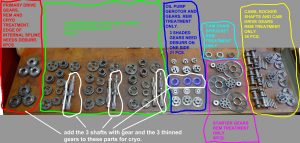Now that the two main shafts have been sent out for initial processing, I can pay a little attention to the other things that go roundy-round inside the engine.
Those components include both transmission shafts, the primary drive system, the oil drive system, the starter geartain, and the other components mounted to the crankshaft.
Some of the gears needed some modifications before they could be used, including the primary drive gears and one of the oil pump drive gears. These parts are made from hardened steel, so a little problematic to modify. Some patience, and a collection of carbide inserts, is necessary to get through the process.
The crank primary needed the cam chain drive machined from one end and the other end shortened, with tapped holes for the generator rotor mounting.
 A quick fab of an adaptor plate and this small subassembly was complete:
A quick fab of an adaptor plate and this small subassembly was complete:
 Some trimming of an oil pump drive gear was a bit easier, mostly because there was less material to remove:
Some trimming of an oil pump drive gear was a bit easier, mostly because there was less material to remove:
 Once all this trimming was done, I had quite a pile of parts that heeded just a little more TLC to earn their place inside my engines.
Once all this trimming was done, I had quite a pile of parts that heeded just a little more TLC to earn their place inside my engines.
When you want your gear and shaft parts to have that extra special finish, turn to REM surface finishing. It is a chemical/mechanical polishing technology that creates an excellent surface finish without affecting overall part tolerances. The benefit is lower friction. Need anything more be said? Nope. But I will anyway. Friction is heat and heat is energy, that stuff we’re all trying (or should be trying) to conserve. Decreasing friction not only provides more power to the rear tire, it is also less heat for the cooling system to dissipate, which for a compact motorcycle design is always an issue. So, friction reduction treatments inside the engine lead to a smaller radiator size outside it. Combined with the demand driven electric water pump, the bike should be able to keep a stable operating temperature without roasting the rider.
 I chose New England Gear Polishing because of their familiarity with processing motorcycle components. I packed all those parts up securely and sent it off. Bob Veeley from NEGP was very helpful with information, and after a short discussion I opted to include a cryogenic treatment for the transmission input shaft, the primary drive gears, and the modified oil pump drive gear. These components have all been modified or used in a non-standard manner, so the small fatigue strength increase provided for by the cryo treatment is a little cheap insurance to keep these parts happy.
I chose New England Gear Polishing because of their familiarity with processing motorcycle components. I packed all those parts up securely and sent it off. Bob Veeley from NEGP was very helpful with information, and after a short discussion I opted to include a cryogenic treatment for the transmission input shaft, the primary drive gears, and the modified oil pump drive gear. These components have all been modified or used in a non-standard manner, so the small fatigue strength increase provided for by the cryo treatment is a little cheap insurance to keep these parts happy.
That pretty much covers the rest of the internal engine components, next posts will detail the machining of the various cast magnesium parts described in this post.



